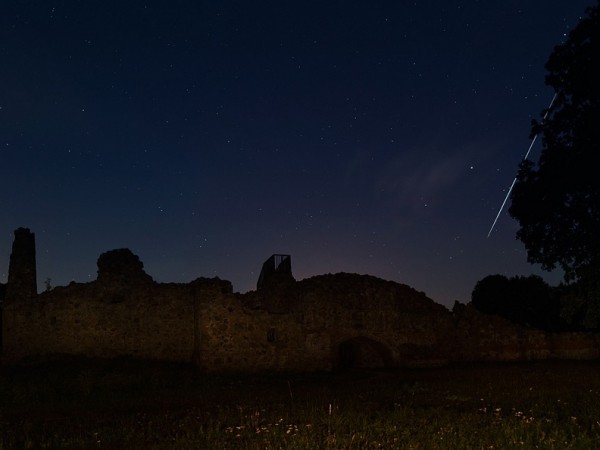Happening Now: Meteor Shower from Eta Aquarids Peaks Tonight
| Ana Verayo | | May 05, 2015 09:27 PM EDT |
(Photo : Slooh Community Observatory) The Eta Aquarid meteor shower runs from April 21 – May 20, 2015 where meteor activity peaks from May 5-6.
Tonight's Eta Aquarid meteor shower will be remembered as the Cinco de Mayo shower where debris from Halley's Comet will be scattered in the night sky.
Later tonight towards the early morning hours of May 6, skygazers and observers will have the opportunity to enjoy bits and pieces of Halley's Comet as "comet litter" where it will span through the planet's atmosphere via meteors.
Like Us on Facebook
Starting at 8 P.M. EDT there will also be a free webcast of the meteor shower from the Slooh community observatory, streaming live at the official website.
Astronomers have predicted that the Eta Aquarid meteor shower will peak tonight into the early hours of tomorrow, May 6. Observers can spot these meteors under ideal conditions (dark, moonless, away from light pollution skies) at a rate of 40 fast meteors every hour. Although, prior to tonight's peak shower, the Eta Aquarids were at a quarter of its peak strength in the last three to four days.
However, there will be some viewing constraints for this sparkling meteor shower as a full moon was looming from Sunday and even if its glow has been waning, the moon will now enter the bright gibbous phase during the peak morning where it can illuminate the sky even more, making fainter meteor streaks disappear in the early morning.
Another obstacle will be for those watching from the northern region of the equator which is called the "radiant" as this will be the emanation point of meteors. This means that the Aquarius constellation will appear on the southeast horizon later at 3 A.M. EDT but it will not be seen at high in the sky unlike north temperate latitudes; meteor sightings will now be less than 40 every hour for this area.
For most night sky watchers, the meteor shower will be emerging from the radiant and will skim the atmosphere in a horizontal manner that are called "Earthgazers" and will leave more colorful than usual, longer lasting trails.
According to Robert Lunsford from the International Meteor Organization, these meteors will be extremely long where they can cover the horizon instead of shooting overhead as most cameras are focused.
According to Bill Cooke from the Space Environments team of the Marshall Space Flight Center, earthgazers are not that many, and for those who can spot them, they will most likely to remember them.
Tonight's meteor shower will be a memorable one since they provide the romantic, incandescent streak from the material originating from Halley's Comet's nucleus. When these bits and pieces fall from the comet and dusting the Earth tonight, friction in the atmosphere transforms them into white heat energy that produces "shooting stars".
Halley's Comet journeys around the sun with an elliptical orbit also taking the orbit of Neptune and the inside orbit of Venus. This orbit takes around 75 years to complete where its last visit to the sun was in 1986. Halley's Comet will return and visit Earth during the summer of 2061.
Tagseta aquarids meteor shower, meteor shower tonight, US, eta aquarids, Halley's Comet, how to watch meteor shower tonight, meteor shower, cinco de mayo meteor shower
©2015 Chinatopix All rights reserved. Do not reproduce without permission
EDITOR'S PICKS
-

Did the Trump administration just announce plans for a trade war with ‘hostile’ China and Russia?
-

US Senate passes Taiwan travel bill slammed by China
-

As Yan Sihong’s family grieves, here are other Chinese students who went missing abroad. Some have never been found
-

Beijing blasts Western critics who ‘smear China’ with the term sharp power
-

China Envoy Seeks to Defuse Tensions With U.S. as a Trade War Brews
-

Singapore's Deputy PM Provides Bitcoin Vote of Confidence Amid China's Blanket Bans
-

China warns investors over risks in overseas virtual currency trading
-

Chinese government most trustworthy: survey
-

Kashima Antlers On Course For Back-To-Back Titles
MOST POPULAR
LATEST NEWS
Zhou Yongkang: China's Former Security Chief Sentenced to Life in Prison

China's former Chief of the Ministry of Public Security, Zhou Yongkang, has been given a life sentence after he was found guilty of abusing his office, bribery and deliberately ... Full Article
TRENDING STORY

China Pork Prices Expected to Stabilize As The Supplies Recover

Elephone P9000 Smartphone is now on Sale on Amazon India

There's a Big Chance Cliffhangers Won't Still Be Resolved When Grey's Anatomy Season 13 Returns

Supreme Court Ruled on Samsung vs Apple Dispute for Patent Infringement

Microsoft Surface Pro 5 Rumors and Release Date: What is the Latest?










